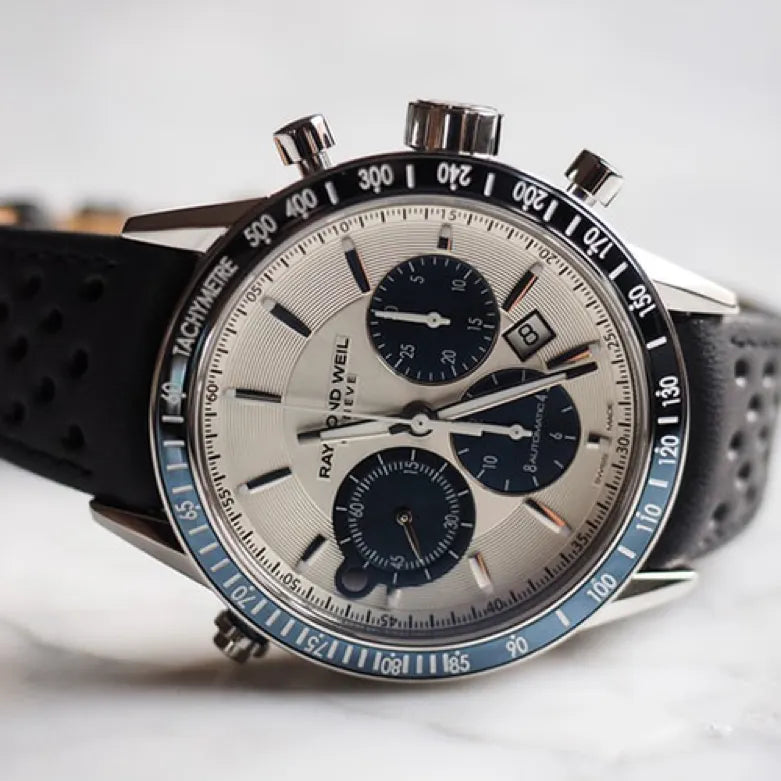
What is a Complication?
Any function of a timepiece in addition to telling time. These watch complications enable special functions that are performed and displayed, such as moon phase, calendar, time zone, and many more.
In this series, we will explore the many complications of luxury timepieces. Understanding complications allows us to learn what specific functions we “can’t live without” in our next timepiece. When you are searching for that perfect addition to your luxury wristwatch collection, complications provide the extra utility that makes a piece special and story-worthy for many years to come. Today we will be looking at one of the most widely utilized complications, the chronograph.
Before discussing how a chronograph functions, we must explore what exactly a chronograph is and is not. You may hear the term chronometer when you are looking for a luxury timepiece and it is important to draw a distinction between a chronometer and a chronograph.
What is a Chronometer?
A chronometer is an instrument used to measure time which has been calibrated and certified to meet specific precision standards. Chronometer means the timepiece falls within standards for keeping time in different positions, at different temperatures, and over several days by an official, neutral testing body.
In Switzerland, only watches that have been certified by the Controle Officiel Suisse des Chronométres or COSC may use the word chronometer.
What is a Chronograph?
A chronograph is an instrument that uses a start/stop and reset function to measure elapsed time. Most chronographs measure seconds using a central seconds hand for the chronograph while the seconds hand for the timekeeping of the wristwatch is displayed in a sub dial.
The chronograph complication is activated by a pusher, usually located at two o’clock. The chronograph itself is often controlled by a column-wheel. The column wheel has teeth on the exterior which act as a ratchet, and columns on top. Columns outnumber the ratchet teeth, which allow the column-wheel to act as a rotating on and off switch for the chronograph complication. When the pusher is engaged to start the chronograph, the column wheel rotates through a lever and starts the complication.
 It is worth noting here the difference between horizontal and vertical clutch movements. While horizontal clutch movements are more aesthetically pleasing and showcased in many high-end movements, the start and stop displays a small “jerk” of the chronograph second's hand. A vertical clutch movement lifts the gearing in and out of place, allowing the hand to start and stop precisely where it lays. This vertical movement also provides a smooth departure for the seconds hand, with almost no perceivable “jerk”.
It is worth noting here the difference between horizontal and vertical clutch movements. While horizontal clutch movements are more aesthetically pleasing and showcased in many high-end movements, the start and stop displays a small “jerk” of the chronograph second's hand. A vertical clutch movement lifts the gearing in and out of place, allowing the hand to start and stop precisely where it lays. This vertical movement also provides a smooth departure for the seconds hand, with almost no perceivable “jerk”.
Once pressed into action, the chronograph complication starts with the column-wheel pushing a lever holding the intermediate chronograph wheel. This wheel engages both the fourth chronograph wheel and center chronograph wheel. The fourth chronograph wheel is attached to the arbor, which makes one revolution per minute. While the complication moves, the intermediate chronograph wheel transfers the rotation of the fourth chronograph wheel to the center chronograph wheel, which rotates the chronograph seconds hand on the center of the dial. Now, the chronograph is moving, but in order to mark elapsed time, a reducing gear train must be established. The center chronograph wheel carries a finger, which moves forward one tooth of the intermediate minute wheel after each minute. The intermediate minute wheel drives the minute wheel, which moves the chronograph minutes hand on the dial, usually in a sub dial.
The complication then marks both the elapsed seconds and minutes through a connected series of wheels and displayed on the face by the seconds and minutes chronograph hands. To stop the complication, the pusher is depressed again. This rotates the column wheel to the off position, disengaging the intermediate chronograph wheel. Additionally, a brake lever touches the center chronograph wheel to bring an immediate halt to all movement of the complication.

Once the chronograph movement has been engaged and disengaged, the measurement of time can be completed. What remains is to reset the complication so that the process can be repeated again and again. This is accomplished through an additional pusher, usually located at the four o’clock position. When the reset pusher is depressed, the chronograph seconds and minutes hands must immediately return to zero. This is accomplished by the use of heart cams which are mounted co-axially on the center chronograph wheel and minute wheel. The reset pusher presses against these heart cams which then rotate their wheels back to the zero position. The complication is then ready to be reactivated from the zero position to once again mark elapsed time from start.
The chronograph is one of the most foundational complications in watchmaking, providing a useful function to nearly anyone, the measurement, to whatever minute degree, of elapsed time. Explore Sylvan's collection of chronographs in-store or online.
